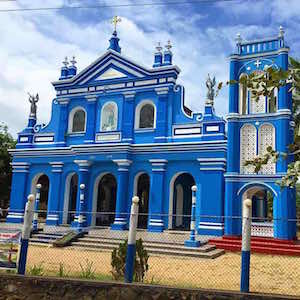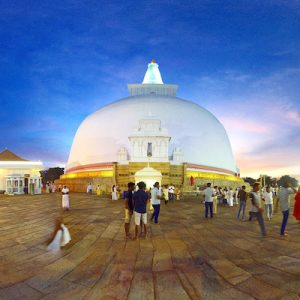Anuradhapura Sri Lanka: Ancient Cities and Traditions
Our first morning starts with a journey from the beachside resorts of Negombo to dry Anuradhapura. We travel past villages that come to life when locals celebrate religious festivals on what would otherwise be a quiet Sunday morning. Today’s trip ends in the original capital of Sri Lanka: Anuradhapura. We enjoy a leisurely lunch before embarking on a tour of Sri Lanka’s cultural origins. We take a guided tour of sacred sites, exploring stupas that were once some of the tallest constructions on the planet. After watching locals perform current day offerings at one of Buddhism’s most sacred sites, our first day comes to an end.
Essential Tour Day Facts and Figures
- Major Destination: Anuradhapura
- Overall distance travelled: 170km (by car)
- Overnight accommodation: Sanctuary at Tissawassa(or similar)
- Activity level: Easy
Touring Route
Early risers can watch the sunrise from the beach as catamarans return to shore with the morning catch. After breakfast, we leave Negombo and pass the local fish markets. The area around the markets is predominantly Muslim, reflecting the long commercial trading history with the Middle East, which saw many Muslim traders eventually settle in Colombo and surrounds.

Our drive from Negombo to Anuradhapura takes anywhere between three and five hours. The architecture of the villages we pass along the way reflect the major religions that are represented in those areas. The area around our Negombo hotel is heavily influenced by the Portuguese and is one of the largest Catholic communities in Sri Lanka. We pass churches where the streets are lined with flags to celebrate significant religious festivals. We stop to admire the beautiful decorations crafted from painted coconuts connected to flags that fly on bunting lines from the church spire.
It’s Sunday morning when we leave Negombo, so traffic is generally light as many locals attend church, temple or mosque. Occasionally however, the road will be closed in a village due to a religious procession, requiring a slight detour. Taking back roads around villages provides an insight into village life as we transverse narrow, rough and windy roads. We see families walking home in their Sunday best, passing ponds, railways, farms, lagoons and small mosques and temples. After Sunday school, children ride their bikes along the paths in their school uniforms.
Further along the journey we pause briefly at a Hindu temple. The enormous statues of Hindu gods are stunning. Our guide explains the various religions and beliefs in Sri Lanka and how the majority Buddhist population holds family and respect for elders as a central way of life.

As we head further north towards Anuradhapura, the climate changes from midzone climate to the dry zone. The dry zone gets over a metre of rainfall each year. Almost all of this falls in the monsoonal season from December to February. We see families bathing in rivers by the side of the road while crossing many rivers and man-made canals on our trip north. Irrigation in Sri Lanka dates back thousands of years and remains an important factor in the survival of these villages.
We break the journey at a British hospital that has been converted into a comfort station for travellers. Sipping on a lemonade in the parlour, you imagine what this place looked like a century ago, when nurses were caring for the sick and injured gentlemen were rocking in chairs with drips from glass bottles. Fortunately, our hydration is more refreshing and the atmosphere more uplifting.
When we arrive in Anuradhapura, we explore the city’s New Town where we can buy a sarong for our visits to sacred sites. These sarongs are extremely practical when visiting the many sacred sites across Sri Lanka. We’ll leave our sarongs in the car for the entire journey, ready for whenever we need them. Our guide delivers us to our centrally located hotel in time for lunch before we explore the ruins of Anuradhapura.
In the afternoon, our guide takes us on an informative tour of some of the best-preserved sites within the Anuradhapura sacred ruins. It would take weeks to explore each and every ruin, so our guide ensures that we come away with a great insight into the best ruins in Anuradhapura. We are encouraged to ask questions and our guide tailors the experience to match the interests of all in the group.

The stupas, refectories and shrines within the sacred site all have their own stories, which our guide takes the time to explain. The condition of each ruin is different. Some stupas tower above us in seemingly pristine condition, while some others have all but disappeared except for the foundations. The citadel complex was once home to thousands of monks learning the Buddhist ways. The Jaya Sri Maha Bodhi, a sapling taken from the tree under which Buddha obtained enlightenment, is an active place of worship.
We conclude our tour of the ruins with a sunset visit to the majestic Ruwanwelisaya Stupa. The stupa is surrounded by pilgrims bringing offerings as the sun sets. We return to our hotel located only minutes from our final stupa. On arrival, we enjoy a leisurely dinner before retiring for the night in colonial inspired rooms, getting ready for the next day of adventures.
Daily Tour Inclusions in Anuradhapura
- Our tour director will escort the group during all group experiences.
- Admission to the Anuradhapura Ancient Sites Complex.
- Breakfast before departure from Negombo and dinner in Anuradhapura.
- Overnight accommodation in Anuradhapura as per tour program.
Departure Dates to Tour Anuradhapura
- This tour departs on selected Saturdays in 2017.
- For full program schedule: Discover Sri Lanka

